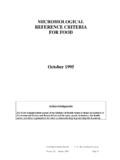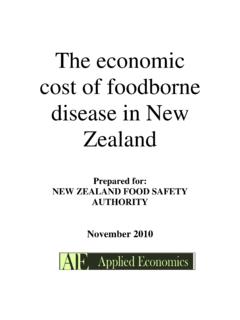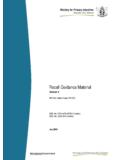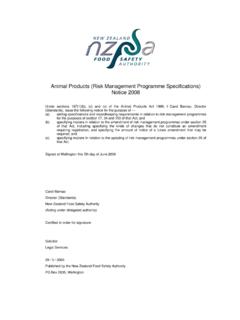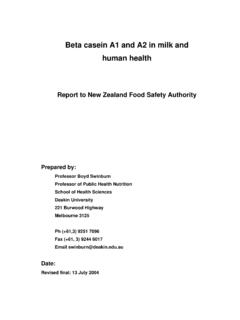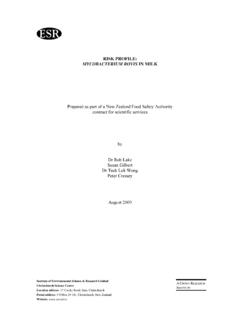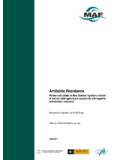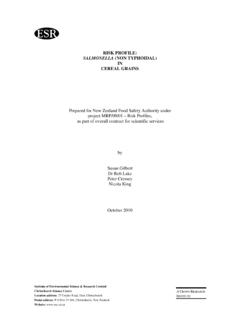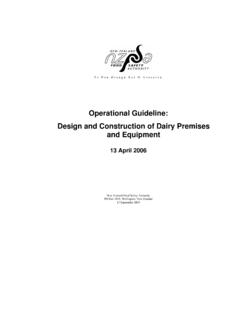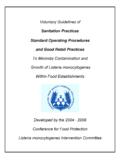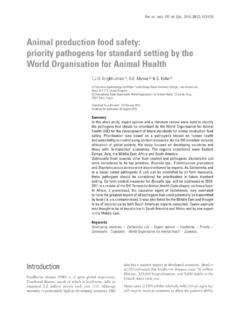Transcription of RISK PROFILE: LISTERIA MONOCYTOGENES IN …
1 RISK profile : LISTERIA MONOCYTOGENES . IN PROCESSED READY-TO-EAT MEATS. Prepared as part of a New Zealand food Safety Authority contract for scientific services by Sue Gilbert Rob Lake Andrew Hudson Peter Cressey December 2009. Institute of Environmental Science & Research Limited Christchurch Science Centre A CROWN RESEARCH. Location address: 27 Creyke Road, Ilam, Christchurch INSTITUTE. Postal address: P O Box 29 181, Christchurch, New Zealand Website: Client Report FW08021. RISK profile : LISTERIA MONOCYTOGENES . IN PROCESSED READY-TO-EAT MEATS. Dr Stephen On food Safety Programme Leader Rob Lake Maurice Wilson Project Leader Peer Reviewer DISCLAIMER. This report or document ( the Report ) is given by the Institute of Environmental Science and Research Limited ( ESR ) solely for the benefit of the New Zealand food Safety Authority ( NZFSA ), Public Health Services Providers and other Third Party Beneficiaries as defined in the Contract between ESR and the NZFSA, and is strictly subject to the conditions laid out in that Contract.
2 Neither ESR nor any of its employees makes any warranty, express or implied, or assumes any legal liability or responsibility for use of the Report or its contents by any other person or organisation. Risk profile LISTERIA MONOCYTOGENES December 2009. in Processed Ready-to-Eat Meats ACKNOWLEDGEMENTS. The authors wish to acknowledge the Ministry of Health as owner of the copyright and funders of the 1997 National Nutrition Survey and the 2002 National Children's Nutrition Survey and to thank them for access to food consumption information (24-hour dietary recall and qualitative food frequency questionnaire) from these surveys. Risk profile LISTERIA MONOCYTOGENES December 2009. in Processed Ready-to-Eat Meats CONTENTS. EXECUTIVE SUMMARY .. 1. 1 STATEMENT OF 3. food /Hazard Combination and Risk Management 4. 2 HAZARD AND 5. LISTERIA 5. Sources of LISTERIA 5. Processed Ready-to-Eat 6. The food Supply in New Zealand .. 7. 7. Imported 8. Behaviour of L. MONOCYTOGENES on processed ready-to-eat meat.
3 9. Exposure 11. LISTERIA in raw 11. LISTERIA in processed ready-to-eat meat products .. 13. food consumption: Processed ready-to-eat meat products .. 15. Qualitative Estimate of Exposure .. 17. Number of servings of ready-to-eat meat and serving size .. 17. Contamination frequency .. 18. Predicted contamination level at retail .. 19. Growth rate during storage and most likely storage 19. Heat 20. Exposure summary .. 20. 3 EVALUATION OF ADVERSE HEALTH EFFECTS .. 21. Listeriosis .. 21. Non-Invasive Febrile Gastroenteritis .. 21. Dose Response .. 22. Adverse Health Effects in New 22. 22. Clinical consequences of LISTERIA infection .. 23. 24. High Risk Groups in the New Zealand 25. Perinatal 26. Elderly population .. 26. Immune compromised .. 26. Adverse Health Effects 27. Health Burden due to Invasive Listeriosis .. 27. 4 EVALUATION OF 28. Existing Risk 28. Estimation of Risk for New 28. risks associated with processed ready-to-eat meats .. 28. risks associated with other 29.
4 Risk assessment options .. 30. Data 30. 5 AVAILABILITY OF CONTROL MEASURES .. 31. Risk profile LISTERIA MONOCYTOGENES December 2009. in Processed Ready-to-Eat Meats Risk Management Strategy .. 31. Regulatory Controls .. 31. Australia New Zealand food Standards 31. food Act and food Hygiene Regulations .. 32. Animal Products Act and Risk Management 32. Codes of Practice .. 33. Microbiological criteria .. 33. Industry controls .. 34. Risk 35. Control 36. Commentary on Control 37. 6 REFERENCES .. 39. APPENDIX 1 HAZARD AND food .. 50. LISTERIA 50. Growth and survival .. 50. Inactivation (CCPs and Hurdles).. 50. Prevalence of LISTERIA in Processed Ready-to-eat Meat Products 51. Handling and 62. APPENDIX 2 EVALUATION OF ADVERSE HEALTH 64. Dose Response .. 64. Listeriosis .. 64. Febrile gastroenteritis .. 65. Adverse Health Effects 66. 66. Contributions to outbreaks and incidents .. 66. Case control studies .. 67. APPENDIX 3 EVALUATION OF RISK .. 71. Risk 71. FAO/WHO .. 71. USA.
5 72. Australia .. 74. Canada .. 78. APPENDIX 4 CONTROL MEASURES OVERSEAS .. 79. Codex .. 79. Australia .. 79. United States of America .. 80. 81. England and 81. 82. Risk profile LISTERIA MONOCYTOGENES December 2009. in Processed Ready-to-Eat Meats LIST OF TABLES. Table 1: Types of processed ready-to-eat meats ..7. Table 2: New Zealand study; prevalence of L. MONOCYTOGENES in various red meat samples (1988) ..12. Table 3: Reported prevalence of LISTERIA in ready-to-eat (RTE) meat products in New Table 4: Reported prevalence of LISTERIA in ready-to-eat poultry products in New Zealand ..15. Table 5: Number of reported cases of invasive listeriosis and mortality from 1997 to 2008. (Williman et al., 2009)..22. Table 6: Outcome data for listeriosis in New Zealand, 1997 - 2008 ..23. Table 7: Relative susceptibility to L. MONOCYTOGENES for certain underlying health Table 8: FSANZ Guidelines for L. MONOCYTOGENES in ready-to-eat Table 9: Results from a LISTERIA spp. knowledge questionnaire, Middlemore Table 10: Reported prevalence of LISTERIA in overseas meat products.
6 54. Table 11: Prevalence of L. MONOCYTOGENES in ready-to-eat meat and poultry, 1990 1999 at 1800 production facilities across the Table 12: L. MONOCYTOGENES in ready-to eat meat products in the European Union, Table 13: Percentage of positive L. MONOCYTOGENES prevalence in ready-to-eat meat and poultry products in the European Union, Table 14: Reported prevalence of L. MONOCYTOGENES and LISTERIA species in overseas ready- to-eat poultry meat products ..60. Table 15: Quantitative data for L. MONOCYTOGENES in overseas ready-to-eat meats and poultry ..61. Table 16: Comparison of listeriosis incidence between countries ..66. Table 17: Overseas listeriosis outbreaks associated with ready-to-eat meat Table 18: Overseas listeriosis outbreaks associated with ready-to-eat poultry consumption ..69. Table 19: Contribution of L. MONOCYTOGENES to foodborne disease outbreaks and incidents Table 20: Case control studies containing information on L. MONOCYTOGENES in ready-to-eat meats.
7 69. Table 21: Predicted relative risk rankings for listeriosis based on the North American sub- population using median estimates on a per serving basis ..73. Table 22: Risk Ranking of smallgoods and L. MONOCYTOGENES (South Australia)..75. Table 23: L. MONOCYTOGENES in processed meat products, Table 24: food categories and action levels (applicable in Australia only) ..80. Table 25: The microbiological criteria for L. MONOCYTOGENES for different categories of food and corresponding action levels in Canada ..81. Table 26: food groups and tolerances for L. MONOCYTOGENES in Risk profile LISTERIA MONOCYTOGENES December 2009. in Processed Ready-to-Eat Meats LIST OF FIGURES. Figure 1: The four steps of the Risk Management Figure 2: Invasive listeriosis notifications by year 1995 Figure 3: Number of listeriosis cases reported by month in New Zealand (January 2000 . January 2008)..24. Figure 4: Dose response models at median values for R for disease caused by L. MONOCYTOGENES *.
8 64. Risk profile LISTERIA MONOCYTOGENES December 2009. in Processed Ready-to-Eat Meats EXECUTIVE SUMMARY. The NZFSA Statement of Intent 2008-2011 identifies control of LISTERIA MONOCYTOGENES as a strategic priority, with the performance indicator being no increase in cases of listeriosis after five years. This Risk profile is intended to help inform the NZFSA LISTERIA MONOCYTOGENES Risk Management Strategy, and to provide a scientific underpinning for associated risk management measures. It is an update of a previous document completed in 2002, and describes the risk to New Zealand consumers from LISTERIA MONOCYTOGENES in processed ready-to-eat meats. The number of invasive listeriosis cases reported every year is very small relative to other forms of potentially foodborne disease. The importance and high burden of the disease derives from the high proportion of serious outcomes for infants and foetuses. The rate of reported invasive listeriosis in New Zealand has been static for many years, and is similar to that found in comparable countries.
9 As in other countries, most cases are sporadic, with outbreaks being rare. There have been only two reported outbreaks involving L. MONOCYTOGENES in New Zealand; one associated with smoked mussels, and one of unknown source producing mainly non-perinatal cases. Both of these outbreaks involved the invasive form of listeriosis. Analysis of Episurv data found 174 cases of listeriosis notified between 2000 and 2007. Foodstuffs implicated (but not confirmed) were noted for 16 cases (9%) which demonstrates the difficulty in determining the source of infection. The incidence of non-invasive disease from L. MONOCYTOGENES infection in New Zealand is unknown. It is not normal practice for clinical laboratories to examine faecal specimens from cases of gastrointestinal disease for the presence of L. MONOCYTOGENES and it might be that more outbreaks will be reported as this form of the disease gains recognition. Two linked New Zealand outbreaks of non-invasive listeriosis have been reported and these involved cooked ready-to-eat meat products.
10 L. MONOCYTOGENES has been detected in a range of New Zealand ready-to-eat meats; the best data are for the most commonly consumed ready-to-eat meat ham, with a prevalence of approximately The median daily consumption of ready-to-eat meats in New Zealand is similar to that for Australia, and somewhat lower than the amounts consumed in the USA. Although the data on imported processed meat products (mostly from Australia) do not clearly identify ready- to-eat meats as such, it appears that the large majority of ready-to-eat meats consumed in New Zealand are produced locally. Ham is the most commonly consumed type of ready-to- eat meat, followed by luncheon meat and corned beef. These would be included in the category of deli meats ranked first for relative risk of listeriosis in the USDA risk assessment. The US risk assessment has also attributed most of the risk from deli meats to those sliced or packaged at retail; this is consistent with the New Zealand surveys that found a higher prevalence of L.
